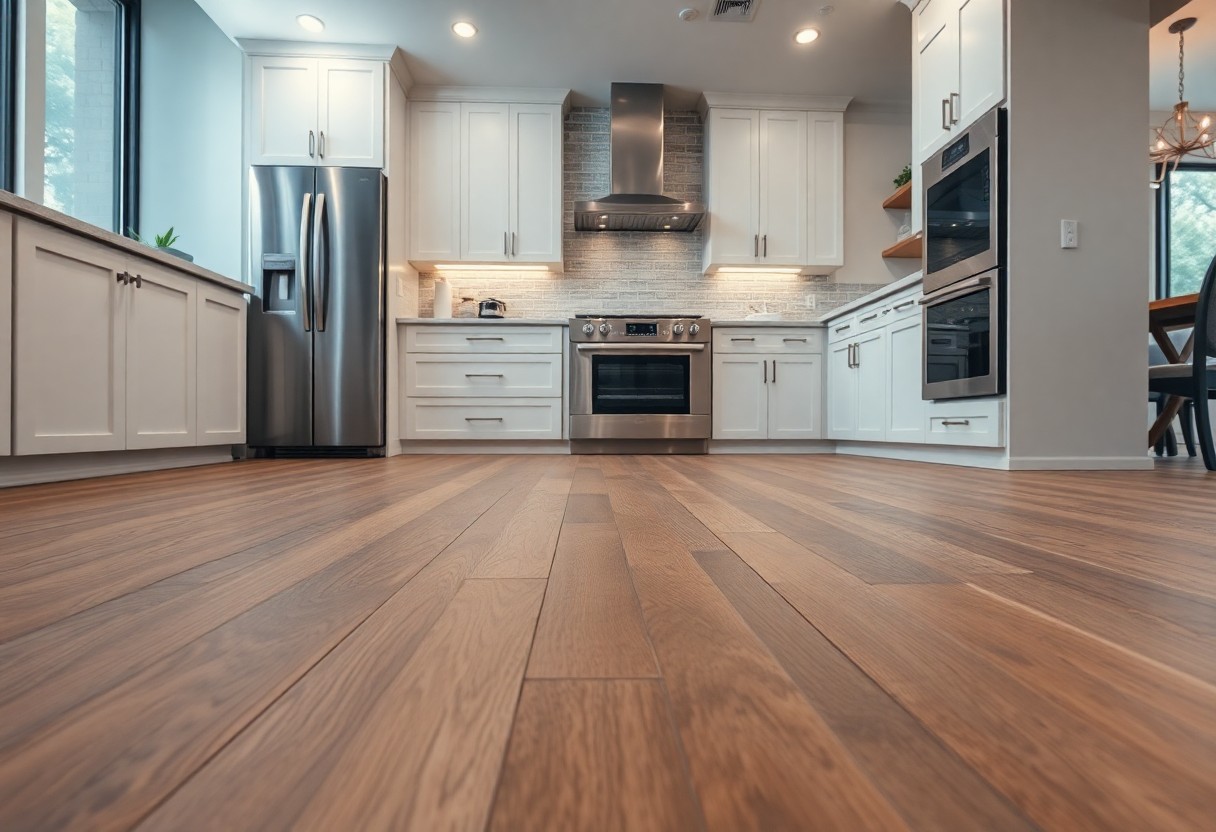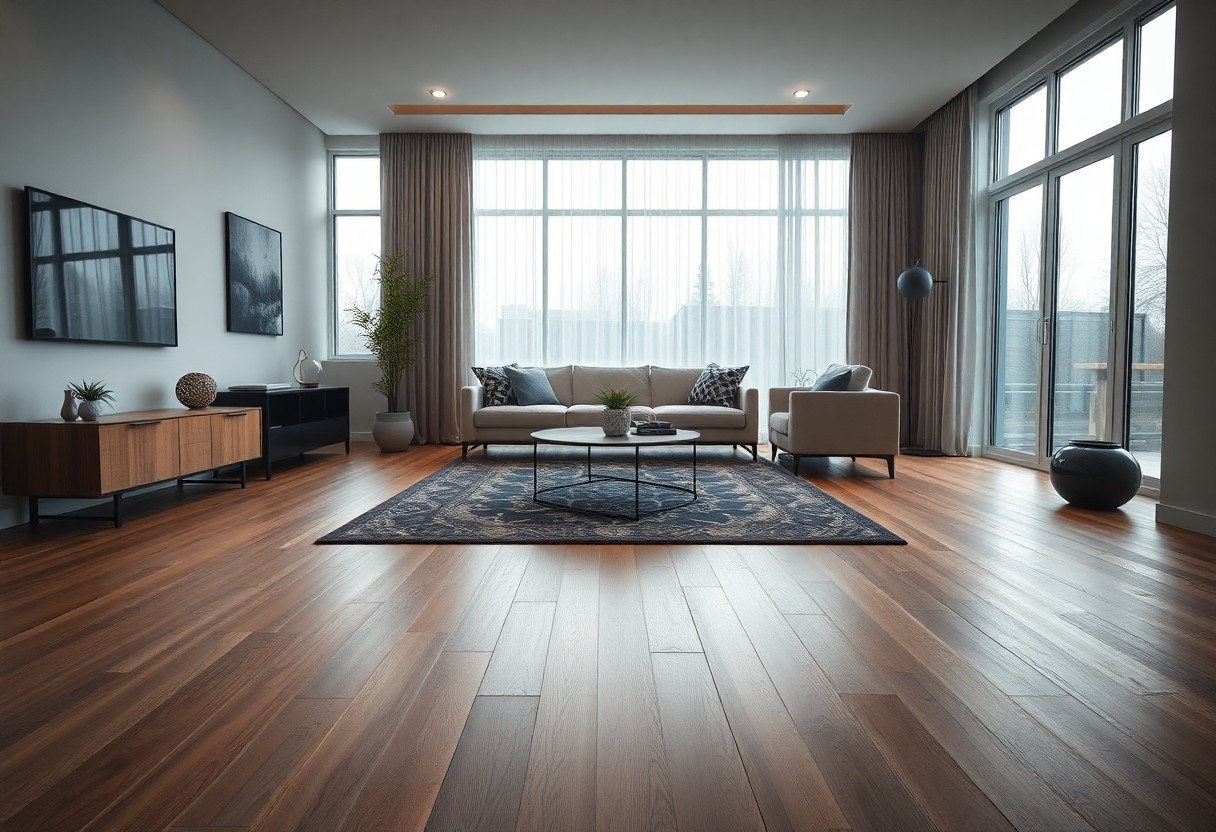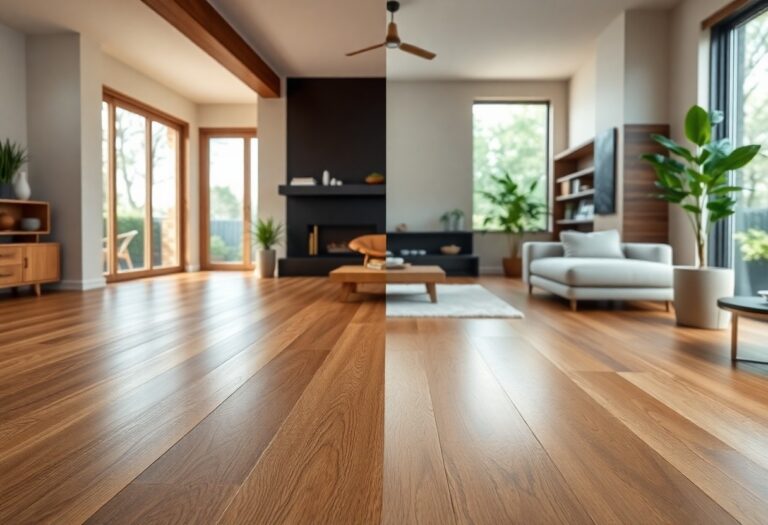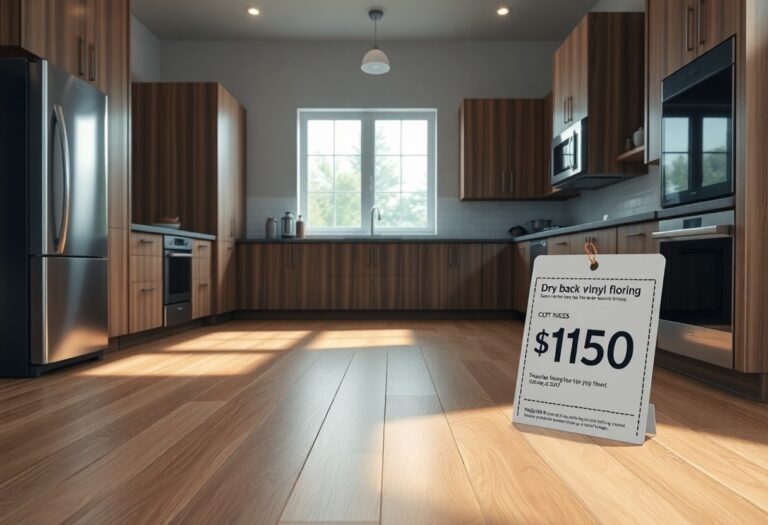Most homeowners overlook the potential of engineered flooring as an investment in long-term value. By choosing engineered flooring, you enhance the aesthetic appeal and functionality of your space while ensuring durability and versatility. This flooring option not only suits various styles and decor but also often proves more cost-effective and environmentally friendly than traditional hardwood. By understanding the benefits of engineered flooring, you can make an informed decision that elevates your home’s marketability and your overall living experience.
Understanding Engineered Flooring
Engineered flooring consists of multiple layers, combining the beauty of hardwood with the structure of plywood. This innovative design allows for greater resistance to environmental changes, such as humidity and temperature fluctuations, making it a practical choice for various settings in your home.
Definition and Composition
Your engineered flooring features a top layer of real hardwood veneer, supported by layers of plywood or high-density fiberboard (HDF) underneath. This layered construction offers durability while retaining the appearance and elegance of traditional hardwood, providing the best of both worlds.
Benefits Over Traditional Flooring
Choosing engineered flooring offers numerous advantages over traditional solid hardwood. Its engineered structure allows for installation in moisture-prone areas like basements and kitchens, where solid wood may warp. Additionally, you’ll find options that deliver increased stability and a faster installation process, often leading to lower labor costs.
From cost savings to versatile installation, engineered flooring presents practical solutions for modern homeowners. For example, while solid hardwood may require re-finishing every few years, many engineered products can withstand daily wear for up to 30 years with minimal upkeep. With a range of finishes available, engineered options can capture any aesthetic you desire, making it easier to align with your home’s style and resale potential.
Aesthetic Appeal of Engineered Flooring
Engineered flooring enhances your home’s aesthetic appeal by offering the luxurious look of solid hardwood while providing practical benefits. With a wide array of species, finishes, and textures, it complements any design style, from modern to rustic. You can achieve a stunning visual effect that increases the overall atmosphere of your space, making it more inviting and elegant.
Design Versatility
One of the standout features of engineered flooring is its design versatility. Whether you prefer a sleek, contemporary style or a warm, traditional look, engineered wood comes in various finishes and colors. This adaptability allows you to customize your floors to match your unique taste and seamlessly integrate with other design elements in your home.
Enhancing Home Décor
Engineered flooring elevates your home décor by adding texture and depth to your interiors. The natural wood grains and patterns create a warm ambiance, enriching your living spaces. You can pair engineered wood with different furnishings, rugs, and wall colors to craft a cohesive design that reflects your personality.
For instance, if you choose a rich walnut finish, it can serve as a stunning backdrop for light-colored furniture, creating a dynamic contrast. Alternatively, opting for a lighter oak can brighten a room and give it an airy feel. Engineered flooring also allows you to showcase decorative accents effectively, such as statement pieces or artwork, making your home both stylish and inviting. The ability to choose various plank widths and lengths further supports your design goals, enabling you to create a personalized aesthetic that adds significant character to your space.

Durability and Longevity
Investing in engineered flooring means securing a long-lasting solution for your home’s flooring needs. With advanced manufacturing techniques, engineered boards are designed to withstand everyday challenges, ensuring that your flooring can endure high foot traffic, moisture, and temperature fluctuations while maintaining its integrity and appearance over time.
Resistance to Wear and Tear
The layered construction of engineered flooring provides exceptional resistance to wear and tear. The top layer, crafted from real hardwood, is finished with durable coatings that resist scratches, dents, and stains, making it ideal for busy households with pets and children. This resilience helps to preserve the floor’s beauty and performance even in high-traffic areas.
Maintenance Requirements
Maintaining engineered flooring is relatively simple compared to solid hardwood. Regular sweeping and occasional damp mopping are usually sufficient for keeping the floors clean, while avoiding harsh chemicals ensures your floor’s finish remains intact. This ease of maintenance translates to effortless upkeep, providing you with more time to enjoy your beautiful space.
To further simplify maintenance, many engineered flooring products feature protective finishes that resist dirt and moisture. You can also use floor mats at entryways to minimize dirt and grit that can scratch the surface. Periodically applying a pH-neutral floor cleaner can help maintain the surface without damaging the protective layer, allowing you to preserve the aesthetic appeal of your flooring for years. Regular checks for signs of wear or damage can also prolong the life of your flooring, making minor repairs as necessary to keep it looking its best.
Cost-Effectiveness
Choosing engineered flooring is not just about aesthetics; it’s also a smart financial decision. While the initial purchase price may be higher than traditional options, engineered flooring delivers longevity and lower installation costs, making it a wise investment. Additionally, its resistance to moisture and wear can reduce future repair and replacement expenses, ultimately saving you money in the long run.
Initial Investment vs. Long-Term Savings
The upfront cost of engineered flooring is often offset by its long-term benefits. For instance, you might pay about $3 to $14 per square foot for quality engineered planks, but consider that they can last up to 30 years with proper care. This longevity translates to a lower cost per year compared to cheaper, low-quality flooring that may require replacement in a fraction of that time.
Impact on Home Resale Value
Investing in engineered flooring can perceptibly enhance your home’s resale potential. Homes featuring high-quality flooring options frequently attract more buyers and can command higher prices in the market. Statistics suggest that properties with upgraded flooring often sell for an average of 1-3% more than similar homes with standard flooring choices.
In many cases, prospective buyers are willing to pay a premium for homes that present an appealing, modern aesthetic. Engineered flooring not only elevates the overall style but also signals durability and quality, making your property more attractive. When you consider that a well-fitted, visually appealing floor can lead to quicker sales and increased offers, the investment proves advantageous for both present enjoyment and future gains. Investing wisely in engineered flooring can lead to tangible returns when it’s time to sell your home, reflecting in both quicker sales and higher offers.
Environmental Considerations
Engineering flooring aligns with growing environmental consciousness by prioritizing sustainability throughout its lifecycle. This flooring option utilizes materials that can reduce deforestation, often sourced from responsibly managed forests. Moreover, engineered flooring’s longevity minimizes the need for frequent replacements, further decreasing waste over time.
Sustainable Manufacturing Practices
Many manufacturers adopt sustainable practices in producing engineered flooring, employing technologies that lower energy consumption and greenhouse gas emissions. By utilizing renewable energy sources and reducing water usage during production, your choice of engineered flooring can support an eco-friendlier industry standard.
Eco-Friendly Options
Today’s market offers a variety of eco-friendly engineered flooring options, including those made with reclaimed wood and low-VOC finishes. These alternatives not only minimize environmental impact but also enhance indoor air quality, contributing to a healthier living environment in your home.
For instance, engineered hardwood flooring certified by organizations like the Forest Stewardship Council (FSC) ensures responsible sourcing and sustainable management of forests. Additionally, options featuring low-emission or no-VOC adhesives and stains help reduce harmful pollutants in your home, making these products safe for both your family and the planet. By choosing these eco-friendly designs, you can enjoy stylish flooring while supporting sustainable practices that resonate with your values.
Installation Process
The installation process of engineered flooring can significantly affect its performance and durability. Generally, it can be installed using three primary methods: nail-down, glue-down, or floating installation. Each method has distinct advantages depending on your subfloor type and the level of moisture in the environment. Floating floors, often preferred by DIY enthusiasts, tend to be quicker, allowing you to walk on them almost immediately after installation.
Professional vs. DIY Installation
Choosing between professional installation and tackling it yourself hinges on your skill level and the scope of your project. Professionals bring expertise, ensuring proper acclimation, subfloor preparation, and installation techniques, which can prevent future issues. However, if you’re confident in your abilities and have some experience with flooring projects, a DIY installation can save you money and provide a sense of accomplishment.
Time and Cost Implications
The time and cost of installation can vary significantly based on your choice. Professional installation typically costs between $1 to $3 per square foot, adding a notable expense to your project. DIY installations, on the other hand, primarily incur costs for materials and tools, allowing you to save on labor but may take longer if you’re inexperienced.
For instance, hiring experts might complete an installation of 1,000 square feet in roughly one to three days, depending on site conditions. Conversely, a DIY approach could stretch over several weekends, factoring in learning curves and potential mistakes. Economic considerations also come into play, as the combined expense of materials and professional work might outweigh saving time with a DIY commitment. Balancing cost and time against your capabilities ultimately guides your decision.
Final Words
Presently, choosing engineered flooring can significantly enhance the long-term value of your home. By investing in this durable and versatile option, you provide your living spaces with the aesthetic appeal and functionality that modern buyers seek. Engineered flooring not only withstands wear and tear better than traditional materials but also offers easy installation and maintenance. As trends evolve, having this quality flooring can set your home apart in the market, ensuring that your investment yields returns when it comes time to sell or refinance.





